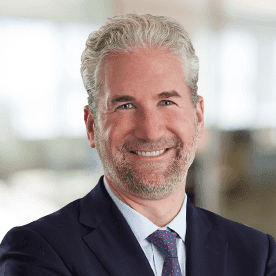And since interest rates began to rise last year, more than $1 trillion of household deposits have left the US banking system, according to the US Federal Reserve Board. That departure adds momentum to the trend of bank retrenchment that began after the global financial crisis—one of many secular trends that transcend economic cycles.
The exodus gathered momentum after several high-profile US regional bank failures in March, forcing banks to shore up capital and reduce lending even further. Many face higher capital requirements and increased regulatory scrutiny, which has prompted them to reduce risk in stressed sectors, sell assets and search for partners to provide financing to their customers.
At the same time, public markets are getting smaller. In the corporate space, companies are increasingly foregoing initial public offerings and turning to alternative sources of capital. All of these trends are creating short-term and long-term opportunities across the risk-return spectrum.
No Time Like the Present
Let’s start with where investors can dig in today. Interest rates are high and likely to stay there, and a recession can’t be ruled out in the US and Europe. We believe a protracted period of slower growth and market disruption plays into the hands of opportunistic credit strategies with experience navigating tight credit environments.
Investors may be able to capitalize on these dynamics by acquiring discounted consumer and commercial loans from banks eager to reduce risk and raise liquidity. For insurance companies and other investors who source capital from customer premiums rather than customer deposits, it may present an opportunity to take over direct origination of a wide range of loans.
We also see opportunities in lending against specific pools of consumer and commercial assets with idiosyncratic cash flows, including residential mortgages, or receivables. Weighing in at more than $5 trillion and growing, this specialty finance market—sometimes referred to as asset-backed lending—is bigger than those for direct lending and private equity combined and comes with diversification benefits and attractive risk-adjusted return potential. But it remains underrepresented in many portfolios.
Commercial Real Estate: Avoid the Broad Brush
The challenges facing the commercial real estate market have made many a headline this year. Much of the focus has been on office space, which has struggled to adapt to post-pandemic work patterns. But the office sector’s challenges may be overshadowing opportunities elsewhere, and with new capital scarce, investors have more space to be selective. Fundamentals are strong in multifamily and industrial buildings, while data centers benefit from the growth of artificial intelligence and rising rental prices as supply struggles to meet demand.
Opportunities also abound in Europe, which has higher office occupancy rates than the United States. For European insurers, commercial real estate may offer a way to generate attractive risk-adjusted returns while matching liabilities and maximizing capital efficiency.
Interest rates have raised coupons and reset prices on existing debt, and with a large wave of maturities coming next year, new originations will come with stronger loan structures and lower leverage levels. That creates a compelling near-term opportunity, in our view.
Playing the Long Game
The evolution of private credit has been driven by direct lending, which today represents nearly half of the entire private credit market. As banks continue to retreat from lending, we expect this sector to continue to provide attractive long-term opportunities for investors.
Deal volume has declined this year due to a sluggish merger-and-acquisition environment. But strategies that focus on companies with strong revenue profiles and diversified customer bases have the potential to deliver attractive income and risk-adjusted returns.
Higher interest rates have generally been a blessing for investors, as higher yields have outweighed the impact of isolated credit impairments on those borrowers who have struggled to manage increased financing costs. Senior secured loans, which are typically floating rate, yield more than 12% today, far above the mid-7% yields on deals issued as recently as mid-2022. The incremental yield has increased the return profile across direct lending, allowing investors to play offense.
But defense is important, too. Lenders today are originating loans to quality borrowers with important structural protections, including large equity cushions and the ability to negotiate protective covenants. This has the potential to mitigate downside risk.
Going Green with Clean Energy Financing
Demand for private market financing for clean energy projects remains high in Europe and was super-charged in the United States last year when Congress passed the Inflation Reduction Act, which steers billions of dollars in subsidies to renewable energy production, including solar and wind projects.
In our view, private investment offers the ability to tap more directly into the renewable energy transition than public markets do. That’s important, because the global push to decarbonize presents a large-scale, multiyear opportunity for debt and equity investments in renewable power, including building out utility-scale green energy storage capacity and upgrading commercial and residential infrastructure. We expect the green shoots of this opportunity to continue to grow in the year ahead.
Markets will face ups and downs as they settle into a period of slower growth and higher rates. But we believe private assets will play an essential role in helping investors navigate the twists and turns ahead.

